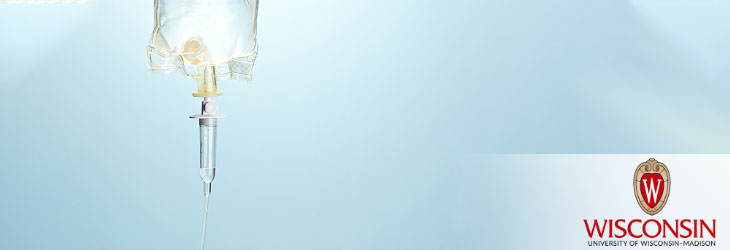Drug Delivery

Efficient Method of Producing Glass with Enhanced Stability
WARF: P06430US
Inventors: Mark Ediger, Stephen Swallen, Ken Kearns, Lian Yu, Tian Wu
The Wisconsin Alumni Research Foundation (WARF) is seeking commercial partners interested in developing an efficient method for producing unusually stable glasses for use as drug coatings, photoresists or organic electronics.
Overview
Many drugs that are potentially efficacious for treating diseases, such as cancer, have limited usefulness because they are relatively insoluble. Preparing these drugs in an amorphous, or “glassy,” form improves their solubility. However, they are less stable in this form than in the more commonly used crystalline form. Coating these compounds with a thin layer of vapor-deposited amorphous material is one option to improve their stability.
Amorphous materials, such as glass, combine the disordered structure of a liquid with the mechanical properties of a solid. In addition to pharmaceutical formulations, they have applications in nanotechnology, advanced photoresists, organic electronics, microchip circuitry and thin films.
Amorphous materials typically are prepared by cooling a liquid. Glass stability can be increased using a method known as aging or isothermal annealing, but this process is extremely slow. Vapor deposition is another option, but glass created using conventional vapor deposition techniques is less stable than material created through the cooling of liquids.
Amorphous materials, such as glass, combine the disordered structure of a liquid with the mechanical properties of a solid. In addition to pharmaceutical formulations, they have applications in nanotechnology, advanced photoresists, organic electronics, microchip circuitry and thin films.
Amorphous materials typically are prepared by cooling a liquid. Glass stability can be increased using a method known as aging or isothermal annealing, but this process is extremely slow. Vapor deposition is another option, but glass created using conventional vapor deposition techniques is less stable than material created through the cooling of liquids.
The Invention
UW-Madison researchers have developed an efficient method of producing extremely stable amorphous material through vapor deposition of organic molecules. The key to their method involves controlling the substrate temperature used for film deposition to 50 K below the glass transition temperature (Tg) of the substance being deposited and depositing the material at a rate of less than 1 nm/s.
Current instrumentation used for vapor deposition typically does not provide a means of controlling the temperature of the substrate. As a result, the substrate generally stays at room temperature, which is not optimal for producing stable glasses. Film layers deposited on these relatively cold substrates “freeze” in place upon deposition with no opportunity to form a stable glass.
The inventors modified their instrument to provide a means of controlling the temperature of the substrate. When the substrate temperature is controlled to about 50 K below Tg and the material in each layer is deposited at a relatively slow rate, the molecules at the surfaces of each layer are mobile enough to pack efficiently with each other, creating a more integrated and therefore more stable glass film.
Current instrumentation used for vapor deposition typically does not provide a means of controlling the temperature of the substrate. As a result, the substrate generally stays at room temperature, which is not optimal for producing stable glasses. Film layers deposited on these relatively cold substrates “freeze” in place upon deposition with no opportunity to form a stable glass.
The inventors modified their instrument to provide a means of controlling the temperature of the substrate. When the substrate temperature is controlled to about 50 K below Tg and the material in each layer is deposited at a relatively slow rate, the molecules at the surfaces of each layer are mobile enough to pack efficiently with each other, creating a more integrated and therefore more stable glass film.
Applications
- Amorphous coatings for pharmaceuticals
- Advanced organic electronic devices, including semiconductors, flat panel displays, medical devices, magnetic storage and optical devices
- Advanced photoresists prepared by vapor deposition
Key Benefits
- Fast—it would take more than 40 to 50 years of isothermal annealing to equal the stability of the glasses produced in less than 10 minutes using this method (for a 100 nm film).
- Amorphous materials have unusually high density and high thermodynamic and kinetic stability.
- Method can be used to form organic and inorganic glasses.
- Additional annealing steps are unnecessary.
Stage of Development
The inventors tested two different organic glasses created using this method. They found that the glasses had higher thermodynamic and kinetic stability than glasses prepared by cooling the liquids of the same substances. Additionally, the glasses they created were more than one percent denser and diffusion was 500 times slower than in typical glass.
Additional Information
For More Information About the Inventors
Tech Fields
For current licensing status, please contact Michael Carey at [javascript protected email address] or 608-960-9867